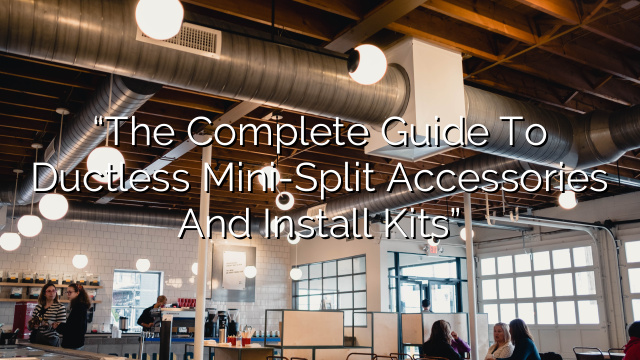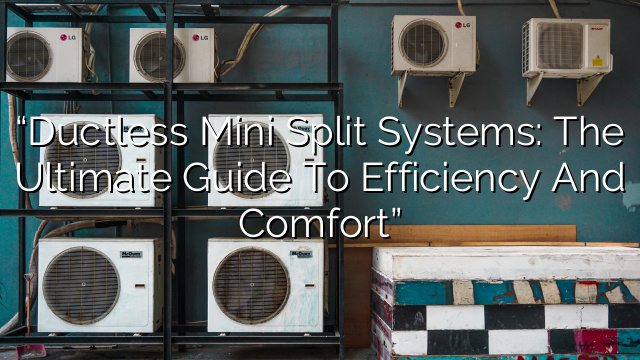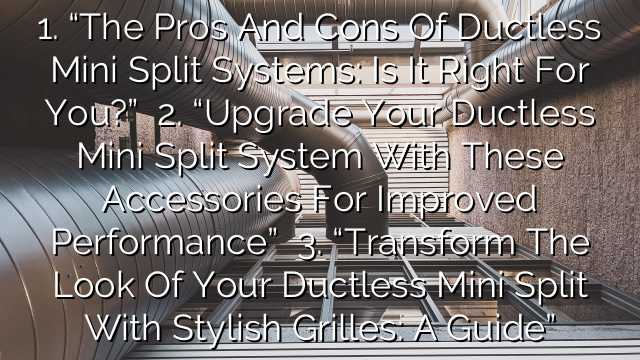Introduction
Ductless mini split systems are a popular and efficient way to heat and cool your home. They offer many advantages over traditional heating and cooling systems, including easy installation, customizable comfort, and improved energy efficiency. In this ultimate guide, we will cover everything you need to know about ductless mini splits, including installation, accessories, and indoor equipment.
Installation
Installing a ductless mini split system is relatively straightforward, making it a great option for both new construction and retrofitting existing homes. Here are the basic steps involved in the installation process:
- Choose the location: The first step is to choose the ideal location for the indoor unit. It should be mounted on an exterior wall and positioned high on the wall for optimal airflow.
- Install the outdoor unit: The outdoor unit houses the compressor and condenser. It should be placed in a well-ventilated and shaded area, away from direct sunlight and any obstructions that could impede airflow.
- Connect the indoor and outdoor units: A small hole is drilled through the exterior wall to connect the indoor and outdoor units. Refrigerant lines, power cables, and condensate drain lines are then run through this hole.
- Mount the indoor unit: The indoor unit is mounted on the wall using brackets and screws. It should be positioned to direct airflow evenly throughout the room.
- Connect the refrigerant lines and power supply: The refrigerant lines and power cables are connected to the indoor and outdoor units, allowing them to communicate and operate together.
- Test and commission the system: Once the installation is complete, the system is tested to ensure proper operation and performance. Any necessary adjustments or fine-tuning are made to optimize comfort and energy efficiency.
Accessories
There are several accessories available for ductless mini split systems that can enhance their performance and convenience. Here are a few popular options:
- Wi-Fi control: Wi-Fi-enabled controllers allow you to control your ductless mini split system from anywhere using your smartphone or tablet. This provides convenient access to temperature adjustments, scheduling, and other system settings.
- Zoning controls: Zoning allows you to divide your home into different temperature zones, each with its own indoor unit. This gives you greater control over comfort and energy usage, as you can heat or cool only the rooms that are in use.
- Smart thermostats: Smart thermostats offer advanced programming features, learning capabilities, and energy usage tracking. They can integrate with other smart home devices and systems, providing a seamless and energy-efficient home automation solution.
- Air purifiers: Adding an air purifier to your ductless mini split system can improve indoor air quality by removing dust, pollen, pet dander, and other allergens. This can be especially beneficial for individuals with allergies or respiratory conditions.
- Dehumidifiers: Ductless mini split systems can also incorporate dehumidification capabilities, helping to remove excess moisture from the air. This can improve comfort, prevent mold and mildew growth, and protect your home and belongings from damage.
Indoor Mini Split Equipment
When it comes to indoor mini split equipment, there are several options to choose from based on your specific needs and preferences. Here are some common types of indoor units:
- Wall-mounted units: Wall-mounted units are the most common type of indoor unit for ductless mini split systems. They are mounted high on the wall and provide efficient and even heating and cooling.
- Floor-mounted units: Floor-mounted units are installed near the floor, making them a great option for providing heating and cooling in rooms with limited wall space or high ceilings.
- Ceiling cassette units: Ceiling cassette units are recessed into the ceiling and provide 360-degree airflow. They are ideal for larger rooms or open-concept spaces.
- Ducted units: Ducted units are concealed within the ceiling or floor and distribute air through ductwork. They are a good choice if you prefer a more discreet and centralized heating and cooling solution.
Each type of indoor unit offers its own unique features and benefits, so it’s important to consider your specific requirements and preferences when choosing the right equipment for your home.
FAQs
Q: Are ductless mini split systems energy efficient?
A: Yes, ductless mini split systems are highly energy efficient. They allow for precise temperature control in individual rooms, eliminating energy waste associated with heating or cooling unused spaces. Additionally, they use advanced technologies, such as inverter-driven compressors, to maximize energy efficiency.
Q: Are ductless mini split systems easy to install?
A: Yes, ductless mini split systems are relatively easy to install compared to traditional heating and cooling systems. They require minimal ductwork, making them a popular option for retrofitting existing homes. However, professional installation is recommended to ensure proper setup and performance.
Q: How long do ductless mini split systems typically last?
A: With proper maintenance and care, ductless mini split systems can last 15-20 years or even longer. Regular filter cleaning or replacement, annual inspections, and professional servicing can help extend the lifespan of the system.
Q: Can I install a ductless mini split system myself?
A: While it is possible to install a ductless mini split system yourself, professional installation is highly recommended. Certified installers have the knowledge and expertise to properly size and install the system, ensuring optimal performance, efficiency, and longevity.
Q: Can ductless mini split systems be used for both heating and cooling?
A: Yes, ductless mini split systems are capable of both heating and cooling. They use a heat pump technology to extract heat from the air and transfer it indoors during the heating season, and vice versa during the cooling season.
Q: Are ductless mini split systems noisy?
A: Ductless mini split systems are designed to operate quietly. The indoor units produce minimal noise, typically less than 30 decibels, which is comparable to a whisper.
Q: Are ductless mini split systems compatible with solar power?
A: Yes, ductless mini split systems can be easily integrated with solar power systems. By combining these two technologies, you can enjoy even greater energy savings and reduce your carbon footprint.
Q: Can ductless mini split systems be used in multi-zone applications?
A: Yes, ductless mini split systems can be used in multi-zone applications. With zoning controls, you can create different temperature zones in your home, each with its own indoor unit, allowing for personalized comfort and energy savings.
Q: Do ductless mini split systems require regular maintenance?
A: Yes, regular maintenance is important to keep your ductless mini split system running smoothly and efficiently. This includes cleaning or replacing filters, inspecting and cleaning the outdoor unit, and scheduling annual professional maintenance check-ups.
Q: Can ductless mini split systems provide both heating and cooling in extreme climates?
A: Ductless mini split systems are designed to provide efficient heating and cooling in a wide range of climates, including extreme cold and hot regions. They use advanced technologies, such as inverter-driven compressors and high-performance insulation, to maintain optimal performance even in extreme conditions.
Conclusion
Ductless mini split systems offer a versatile and efficient solution for heating and cooling your home. With easy installation, a wide range of accessories, and various indoor equipment options, they can be customized to fit your specific needs and preferences. Whether you are looking to retrofit your home or build a new one, ductless mini splits provide enhanced comfort, energy savings, and flexibility. Consider installing a ductless mini split system to experience the benefits firsthand.












